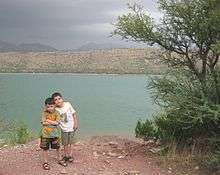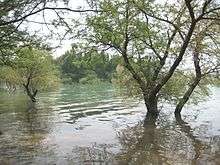Kohat District
| Kohat District | |
|---|---|
| District | |
| Country | Pakistan |
| Province | Khyber Pakhtunkhwa Province |
| Headquarters | Kohat |
| Area | |
| • Total | 2,545 km2 (983 sq mi) |
| Population (2014) | |
| • Total | 949,000 |
| • Density | 221/km2 (570/sq mi) |
| Time zone | PST (UTC+5) |
Kohat is a district of the Khyber Pakhtunkhwa province of Pakistan, Kohat city is the capital of the district. It is inhabited by various Pashtun tribes such as Afridi, Khattak, Bangash and the Orakzai.
Languages
Kohat region has undergone a chequred history and has been the melting pot for various communities as far as the Qandahar and Mazar Shrif in the North and those from the Peshawar region and Bannu region in the south. Historically it was home of local Kohatis who use to speak Kohati or Hindko language. After demographic changes in recent decades due to Afghan Refugees and Tribal peoples arrival, Pashto language speakers are in majority today. Urdu being National language is also spoken and understood.
Tribes
The main tribes of Kohat are Banoori, Mian Khel, Bangash, Kohati Hindkown, Orakzai, Shinwari, Afridi, Niazi, Qureshi and Paracha
Mughal era
From the early sixteenth century the history of Kohat revolves around three major tribes namely Bangash, Banoori, and Afridi .[1] These people appear to have settled in the district, during 14th and 15th centuries. From 16th to 18th centuries, Kohat being part of Mughal Empire was administered by the Chiefs of two afore mentioned tribes. In the beginning of 19th century Kohat came under the control of Sikhs who ultimately withdrew leaving to the administrative control of Khan of Teri in 1836.
Bangash era
About 16th century, the Bangash tribe elder who was named Khalid Khan came from Gardez and attacked the Kohat and occupied it.
British era
Kohat was annexed to the British dominion on 28 March 1849 with the rest of Punjab and an Assistant Commissioner was posted there to run the administration and to look after the British interests. In the initial stages of the British administration, the locals of the area posed considerable problems. Later on, some of the tribe joined with the British government and helped them in running the area. Nevertheless, the Britishers were never at peace in this part of their kingdom as resistance and opposition always cropped from one quarter or the other. But their tactics of "Divide and Rule" ultimately strengthened their hold over the region. They put one tribe against the other by giving preference to one against the other and finally succeeded in administering them. An example of unrest against the British in this area is the event of the brave Afridi Ajab Khan, who forced the entire British administration of the district to surrender to his demands.
Geography
District Kohat shares border with Peshawar to the North. To the East is the Indus river and the districts Attock and Punjab. To the south are Karak and Hangu districts. It remains surrounded though by the semi-autonomous territories of Darra Adam Khel and the Tirah territory.
Famous places

- Khushal Garh Bridge, built by the British before 1900.
- Tanda lake
- Friendship Tunnel, built with Japanese help. The leading Japanese firm M/S Taisie Corp designed and executed the tunnel and its total length is about 1.9 kilometers.
Defence installation
- ISSB Inter Services Selection Board.
- Army Signal Center.
- PAF Air Base. (British era small runway).
Education
- Board of Intermediate and Secondary Education, Kohat
- Kohat University of Science and Technology
- Khyber Medical University, Institute of Medical Sciences (KIMS)- Medical College
- Khyber Medical University, Institute of Dental Sciences (KIDS)- Dental College
- Post Graduate College Kohat
- Cadet College Kohat
- Government College Of Technology, Kohat
- Government Commerce College
Health
- Liaqat Memorial Hospital
- Shifa Eye Hospital
- District Headquarters Teaching Hospital
Irrigation
- The Tanda Dam in the west of Kohat city.

Administration
Kohat district is divided into two Tehsils:
- Kohat
- Lachi (Lachi is one of the largest village of Kohat. Situated on the southern border with Karak district)
The district is represented in the provincial assembly by three elected MPAs who represent the following constituencies:[2]
- PF-37 (Kohat-1)
- PF-38 (Kohat-2)
- PF-39 (Kohat-3)
- NA-14 (Kohat)
References
Coordinates: 33°20′N 71°10′E / 33.333°N 71.167°E
